1993 BUICK REGAL towing
[x] Cancel search: towingPage 70 of 308

To start your 3.1 Liter (Code T) engine:
1. Don’t push
the accelerator pedal before starting your
engine. In some other vehicles you might need to do
this, but because of your vehicle’s computer systems,
you don’t.
starts, let
go of the key. The idle speed will go down
as your engine gets warm.
2. Turn your ignition key to “Start.” When the engine
omng your Key In “Start” for longer tna
seconds at a time will cause your battery to
t
drained much sooner. And the excessive hear
3. If your engine won’t start (or starts but then stops), it
could be flooded with too much gasoline. Try
pushing your accelerator pedal all the
way to the
floor and holding it there
as you hold the key in
“Start” for about three seconds. If the vehicle starts
briefly but then stops again, do
the same thing, but
this time keep the pedal down for five
or six seconds.
This clears the extra gasoline from the engine.
[ electronics in your vehicle. If you add electrical
parts or accessories, you could change the way
the fuel injection system operates. Before adding
electrical equipment, check with your dealer.
1-
you don’t, your engine might not perforn
properly.
If you ever have to have your vehicle towed, see
the part
of this Manual that tells how to do it
without damaging your vehicle. See “Towing
Your Vehicle” in the Index.
4
-$,.-q*+&< ..,-. >%--:* ..“I)“:.. , .--..:<::.,: m.v;,,, ,‘‘Tmy, ““,u, .; ::x,.* ..,, L, W“ . , ~’‘&&‘, ’~=:.*>:** . .. l\l_ $p;Y-.T@ b
68
ProCarManuals.com
Page 73 of 308
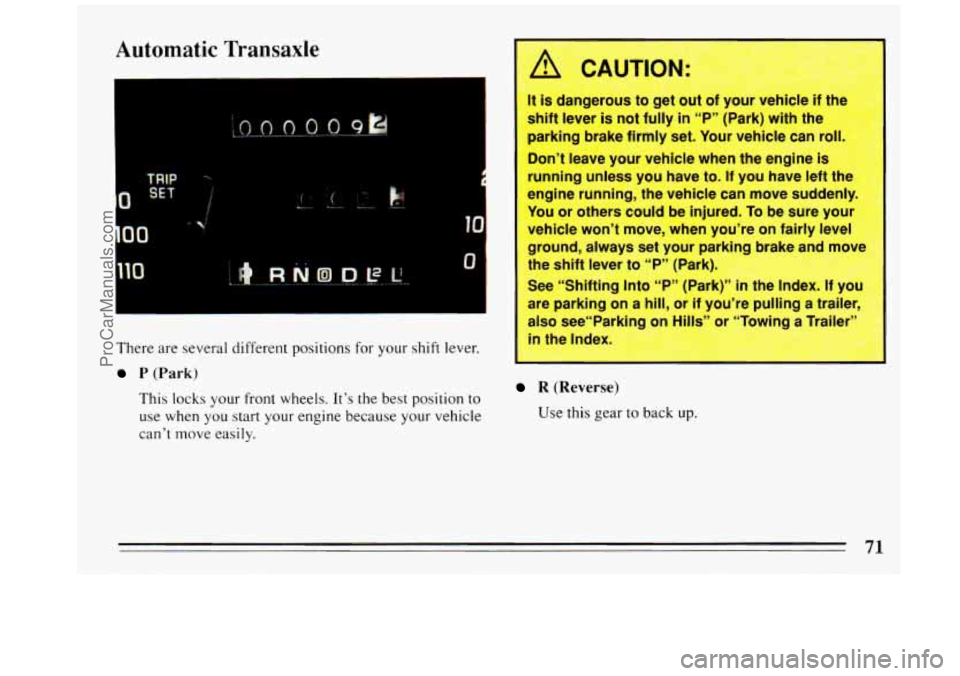
Automatic Transaxle
1
1%.
There are several different positions for your shift lever.
P (Park)
This locks your front wheels. It’s the best position to
use when you start your engine because your vehicle
can’t move easily.
A CAUTION:
It is dangerous to get out of your vehicle if the%
shift lever is not fully in “P” (Park) with the
parking brake firmly set. Your vehicle can roll.
Don’t leave your vehicle when the engine
is
running unless you have to. If you have left tht
engine running, the vehicle can move suddenly.
You or others could be injured. To be sure your
vehicle won’t move, when you’re on fairly level
ground, always set your parking brake and move
the shift lever to “P” (Park).
See “Shifting Into “P” (Park)”
in tl Index. I1 ;
are parking on a hill, or if you’re puliing a traller,
also see“Parking on Hills” or “Towing a Trailer”
R (Reverse)
Use this gear to back up.
71
ProCarManuals.com
Page 75 of 308
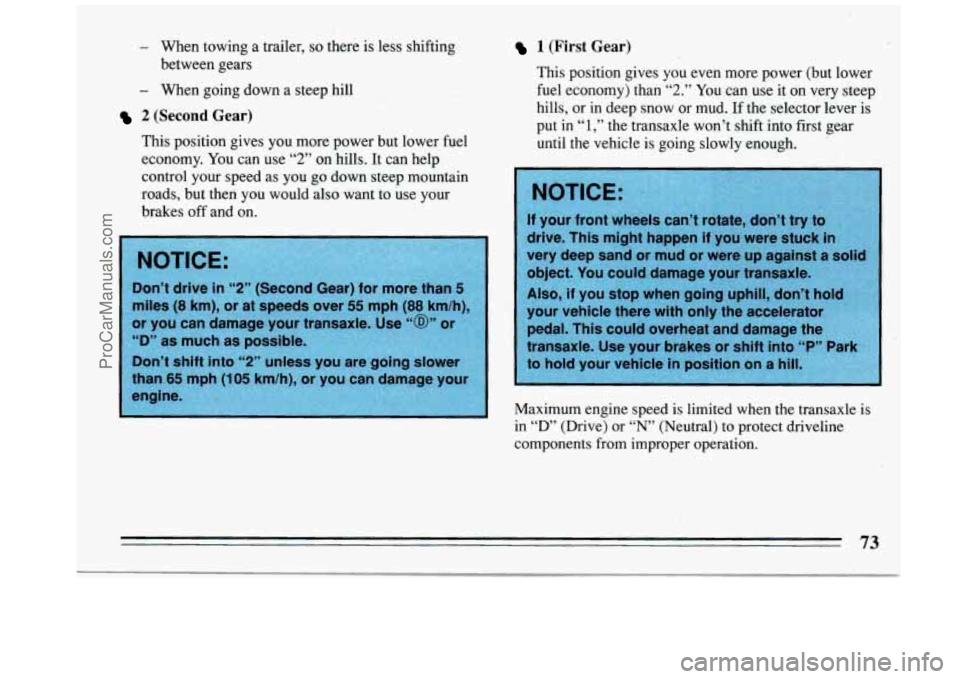
- When towing a trailer, so there.is less shifting
- When going down a steep hill between gears
’ 2 (Second Gear)
This position gives you more power but lower fuel
economy. You can use
2 on hills. It can help
control your speed as you go down steep mountain
roads, but then you would also want
to use your
brakes
off and on.
bb 97
miles (8 km), or at speeds over 55 mph (88 kmih),
or you can damage your transaxle. Use
‘@” or
“D” as much as possible.
Don’t shift into
“2” unless you are going slower
1 (First Gear)
This position gives you even,more power (but lower
fuel economy) than
“2.” You can use it on very steep
hills, or in deep snow
or mud. If the selector lever is
put’in
“1 ,” the transaxle won’t shift into first gear
until the vehicle
is going slowly enough.
Maximum engine speed
is limited when the transaxle is
in “D” (Drive) or
“N” (Neutral) to protect driveline
components from improper operation.
73
ProCarManuals.com
Page 77 of 308
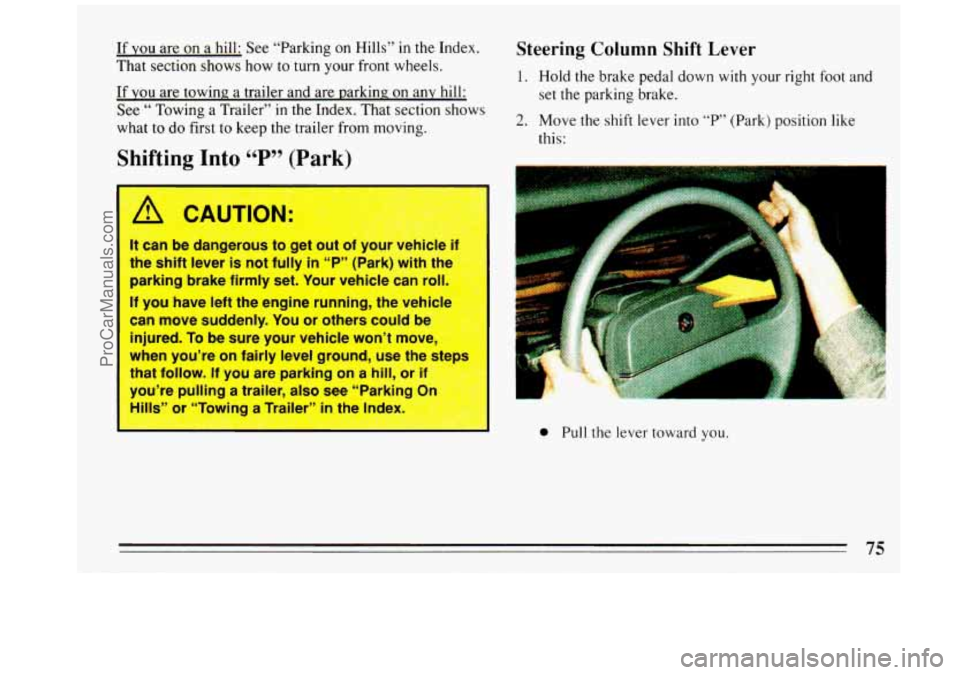
If YOU are on a hill: See “Parking on Hills” in the Index.
That section shows how to turn your front wheels.
If
you are towing. a trailer and are parking on any hill:
See
“ Towing a Trailer” in the Index. That section shows
what to do first to keep the trailer from moving.
Shifting Into 66 P 99 (P-k)
It can be dangerous to ger out of your vehicle if
the shift lever is not fully
in “P” (Park) with the
parking brake firmly set. Your vehicle can rol~
If you have left the engine running, the vehicl
can move suddenly. You or others could be
injured.
To be sure your vehicle won’t move,
when you’re on fairly level ground, use the
steps
that follow. If you are parking on a hill, or if
you’re pulling a trailer, also see “Parkinc 3n
Hills” 2r “Towing a Traile-” ’- the lrT’?x.
Steering Column Shift Lever
1. Hold the brake pedal down with your right foot and
set the parking brake.
2. Move the shift lever into “P77 (Park) position like
this:
0 Pull the lever toward you.
75
ProCarManuals.com
Page 81 of 308
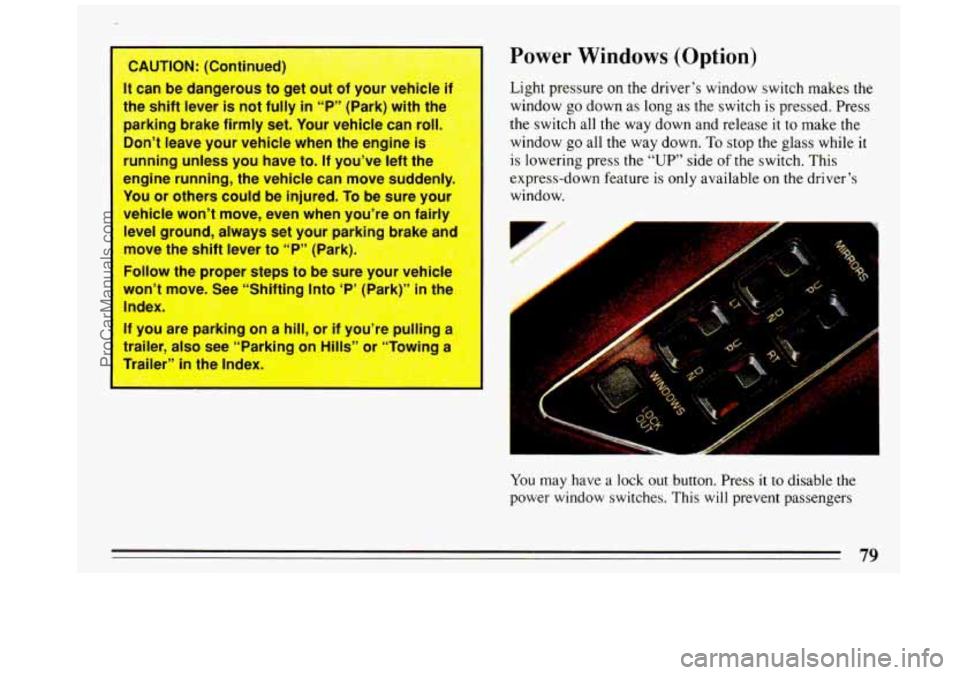
f
-
CAUTION: (Continued)
It can be dangerous to get out of your vehicle if
the shift lever
is not fully in “P” (Park) with the
parking brake firmly set. Your vehicle can roll.
Don’t leave your vehicle when the engine is
running unless you have to. If you’ve left the
engine
running, the vehicle can move suddenly.
You or others could be injured. To be sure your
vehicle won’t move, even when you’re
on fairly
level ground, always set your parking brake and
-we the shift lever to “P” (Park)
Follow the proper steps to be sure your vehicle
won’t move. See “Shifting Into ‘P’ (Park)”
in the
Index,
If you are parking on a hill, or if you’re pulling a
iler, also see “Parking on Hills” or “Towing a
ailer”
in the Index.
Power Windows (Option)
Light pressure on the driver’s window switch makes the
window go down as long as the switch is pressed. Press
the switch all the way down and release
it to make the
window go all the way down. To stop the glass while
it
is lowering press the “UP” side of the switch. This
express-down feature is only available
on the driver’s
window.
You may nave a lock out button. Press it to disable the
power window switches. This will prevent passengers
79
-
ProCarManuals.com
Page 104 of 308

Brake System Warning Light
(a)(!)
BRAKE
Your Buick’s hydraulic
brake system is divided into
two parts. If one part isn’t
working, the other part can
still work and stop you. For
good braking, though, you
need both parts working well.
If the warning light goes on, there could be a brake
problem. Have your brake system inspected right away.
This light should come on as you start the vehicle.
If it
doesn’t come on then, have it fixed
so it will be ready to
warn you if there’s a problem. This
light will also come on when you set your parking
brake, and will stay on if your parking brake doesn’t
release fully. If it stays
on after your parking brake is
fully released, it means you have a brake problem. If the
light comes on while driving, pull off the road and stop
carefully. You may notice that the pedal is harder
to
push. Or, the pedal may go closer to the floor. It may
take longer to stop.
If the light is still on, have the
vehicle towed for service. (See “Towing Your Vehicle”
in the Index.)
A CAUTION:
Your brake system may not be working properly
if the brake warning light is on. Driving with the
brake warning light on can lead to an accident.
If
the light is still on after you’ve pulled off the road
and stopped carefully, have the vehicle towed fo
service.
aw,Tp 1 e- c -
102
ProCarManuals.com
Page 129 of 308
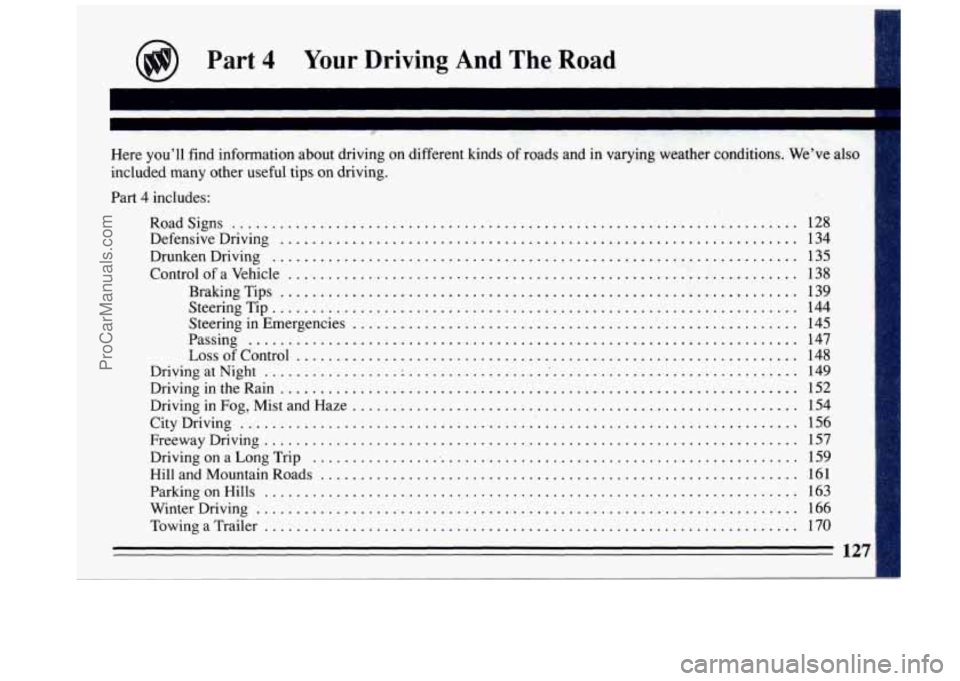
@ Part 4 Your Driving And The Road
.
..
Here you'll find information about driving on different kinds of roads and in varying weather conditions . We've also
included many other useful tips
on driving .
Part 4 includes:
Roadsigns
....................................................................... \
DefensiveDriving .................................................................
ControlofaVehicle ................................................................
BrakingTips .................................................................
SteeringTip ..................................................................
Passing .....................................................................
LossofControl ...............................................................
DrivingatNight ....................................................................
DrivingintheRain .................................................................
Driving in Fog, Mist and Haze ........................................................
CityDriving ....................................................................... \
FreewayDriving ...................................................................
DrivingonaLongTrip ............................................................
HillandMountainRoads ..........................................................
ParkingonHills ...................................................................
WinterDriving ....................................................................
TowingaTrailer ...................................................................
DrunkenDriving ..................................................................
Steering in Emergencies ........................................................
128
134
135
138
139
144
145
147
148
149
152
154
156
157
159
161
163
166
170
ProCarManuals.com
Page 172 of 308
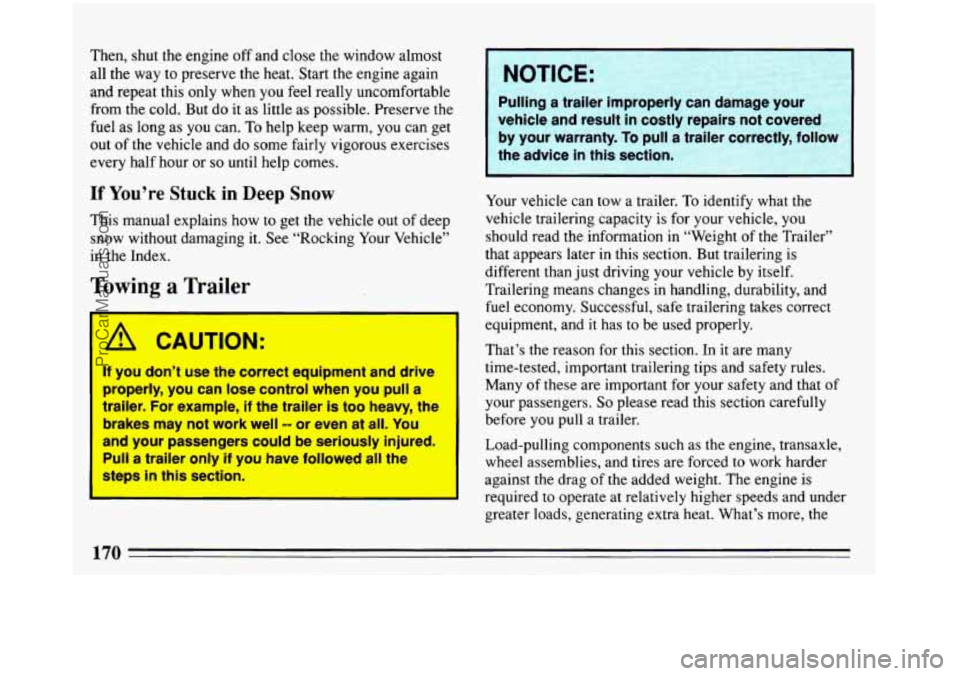
Then, shut the engine off and close the window almost
all the way to preserve the heat. Start the engine again
and repeat this only when you
feel really uncomfortable
from the cold. But do it as little
as possible. Preserve the
fuel as long as you can.
To help keep warm, you can get
out
of the vehicle and do some fairly vigorous exercises
every half hour
or so until help comes.
If You’re Stuck in Deep Snow
This manual explains how to get the vehicle out of deep
snow without damaging it. See “Rocking Your Vehicle”
in the Index.
Towing a Trailer
(n CAUTION:
If you don’t use the correct equipment and drive
properly, you can
lose control when you pull a
trailer. For example,
if the trailer is too heavy, the
brakes may not work well
-- or even at all. You
and your passengers could be seriously injured.
Pull a trailer only if you have followed all the
steps
in this section.
I NOTICE:
Pulling a trailer improperly can damage your
vehicle and result
in costly repairs not covered
by your warranty.
To pull a trailer correctly, follov
the advice in this section. ‘I
Your vehicle can tow a trailer. To identify what the
vehicle trailering capacity is for your vehicle, you
should read the information in “Weight
of the Trailer”
that appears later in this section. But trailering is
different than just driving your vehicle by itself.
Trailering means changes in handling, durability, and
fuel economy. Successful, safe trailering takes correct
equipment, and it has
to be used properly.
That’s the reason for this section. In
it are many
time-tested, important trailering tips and safety rules.
Many
of these are important for your safety and that of
your passengers.
So please read this section carefully
before
you pull a trailer.
Load-pulling components such as the engine, transaxle,
wheel assemblies, and tires are forced to work harder
against the drag of the added weight. The engine is
required to operate at relatively higher speeds and under
greater loads, generating extra heat. What’s more, the
170
- -
ProCarManuals.com